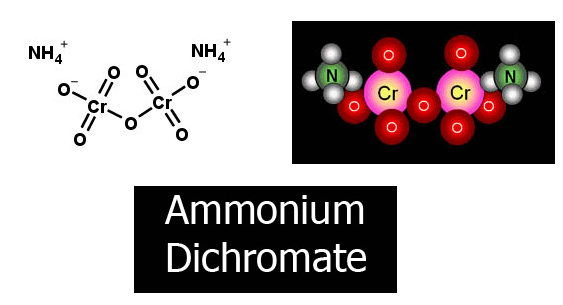What is Ammonium Dichromate?
Ammonium dichromate is a flammable inorganic compound with the chemical formula (NH4)2Cr2O7.
Ammonium dichromate is orange-red needles produced during crystallization. A toxic chemical salt used to sensitize organic emulsions such ad gelatin to the hardening effect of actinic light. It is more sensitive to light.
IUPAC name – diammonium oxido-(oxido-dioxo-chromio)oxy-dioxo-chromium
Table of Contents
- Ammonium Dichromate Structure
- General Properties of Ammonium Dichromate
- Physical Properties of Ammonium Dichromate
- Chemical Properties of Ammonium Dichromate
- Uses of Ammonium Dichromate
- Frequently Asked Questions – FAQs
Ammonium Dichromate Structure – (NH4)2Cr2O7
General Properties of Ammonium Dichromate – (NH4)2Cr2O7
| H8Cr2N2O7 | Ammonium Dichromate |
| Density | 2.12 g/cm³ |
| Molecular Weight/ Molar Mass | 252.07 g/mol |
| Autoignition temperature | 190 °C |
| Melting point | 180 °C |
| Chemical Formula | (NH4)2Cr2O7 |
Physical Properties of Ammonium Dichromate – (NH4)2Cr2O7
| Odour | Odourless |
| Appearance | Orange-red crystals |
| Stability | Stable under recommended storage conditions |
| Specific Gravity | 2.1500 |
| Solubility | Insoluble in acetone; soluble in alcohol |
Chemical Properties of Ammonium Dichromate – (NH4)2Cr2O7
-
- On heating, Ammonium dichromate undergoes decomposition resulting in the formation of chromium(III) oxide and nitrogen gas.
(NH4)2Cr2O7(s) → Cr2O3(s) + N2(g) + 4H2O(g)
Uses of Ammonium Dichromate – (NH4)2Cr2O7
- Ammonium dichromate is used in sensitizing solutions used in lithography.
- Used in pyrotechnics, lithography and photoengraving. It is also used as a magnetic recording material.
- It is used as an approved pesticide and used as a mordant for dyeing, used as a pigment.
Frequently Asked Questions – FAQs
What are the uses of ammonium dichromate?
Ammonium dichromate has been used as a source of pure nitrogen in the laboratory and also as a catalyst in pyrotechnics. This compound also played an important role In the early days of photography as well as in lithography. It is also used in the manufacture of alizarin, chromium alum, leather tanning, and oil purification as a mordant for dyeing pigments.
What happens when ammonium dichromate is heated?
Upon heating, ammonium dichromate decomposes to create nitrogen dioxide, water vapour (Water is gaseous in this reaction due to the relatively high reaction temperature), and solid chromium (III) oxide.
Is ammonium dichromate ionic or covalent?
The ammonium dichromate molecule can be considered as an ionic compound because it features an ionic bond between the ammonium cation and the dichromate anion. However, the individual polyatomic cation and anion are held together by covalent bonds.
Is ammonia bicarbonate baking soda?
NH4HCO3, or ammonium bicarbonate, is a typical leavening agent that produces CO2 without the use of an acid. It doesn’t have the alkaline flavour of baking powder or soda.
Why does baking soda smell like ammonia?
Baking soda will react like an acid, resulting in the formation of tiny amounts of sodium ammonium carbonate. When baking soda is combined with an ammonium salt and water, ammonia is produced.



Comments